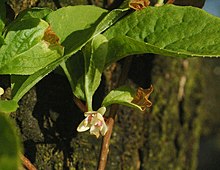| Schisandraceae Temporal range: Possible Albian record
| |
|---|---|

| |
| Scientific classification | |
| Kingdom: | Plantae |
| Clade: | Tracheophytes |
| Clade: | Angiosperms |
| Order: | Austrobaileyales |
| Family: | Schisandraceae Blume[2] |
| Genera | |
Schisandraceae is a family of flowering plants with 3 known genera and a total of 92 known species.[3][4] Such a family has been recognized by most taxonomists, at least for the past several decades. Before that, the plants concerned were assigned to family Magnoliaceae and Illiciaceae.
The APG IV and APG III systems of taxonomy recognize this family and place it on the order Austrobaileyales.[3][4]
The APG II system, of 2003, also recognizes such a family. It places the family in order Austrobaileyales, which in turn is accepted as being among the most basic lineages in the clade angiosperms. APG II assumes this to be a family of three genera, the Schisandraceae sensu lato. This family consists of woody plants, containing essential oils.
| Schisandraceae | |
However, APG II does allow the option of segregating the genus Illicium as the family Illiciaceae. This leaves only two genera in the family Schisandraceae sensu stricto, consisting of Schisandra and Kadsura, totalling several dozen species, which are found in tropical to temperate regions of East and Southeast Asia and North America.[5][6][7]
The APG system, of 1998, recognized both the families Schisandraceae sensu stricto and Illiciaceae, unplaced as to order. It regarded both families as being among the most basic lineages in the clade angiosperms.
The Cronquist system, of 1981, treated the plants in the family (in its wider sense) as two separate families, which together constituted
- the order Illiciales,
- in subclass Magnoliidae,
- in class Magnoliopsida [=dicotyledons],
- of division Magnoliophyta [=angiosperms].
- in class Magnoliopsida [=dicotyledons],
- in subclass Magnoliidae,
- ^ "Austrobaileyales". www.mobot.org. Retrieved 2023-06-18.
- ^ Angiosperm Phylogeny Group (2009). "An update of the Angiosperm Phylogeny Group classification for the orders and families of flowering plants: APG III". Botanical Journal of the Linnean Society. 161 (2): 105–121. doi:10.1111/j.1095-8339.2009.00996.x. hdl:10654/18083.
- ^ a b Cite error: The named reference
APGIVwas invoked but never defined (see the help page). - ^ a b Cite error: The named reference
APGIIIwas invoked but never defined (see the help page). - ^ "Kadsura, Schisandra Distribution Pages". Plants of the World Online. Kew Science. Retrieved 4 November 2017.
- ^ Saunders, Richard M. K. (March 20, 2000). "Systematic Botany Monographs". The American Society of Plant Taxonomists. 58 (Monograph of Schisandra (Schisandraceae)).
- ^ Saunders, Richard M. K. (June 22, 1998). "Systematic Botany Monographs". The American Society of Plant Taxonomists. 54 (Monograph of Kadsura (Schisandraceae)).